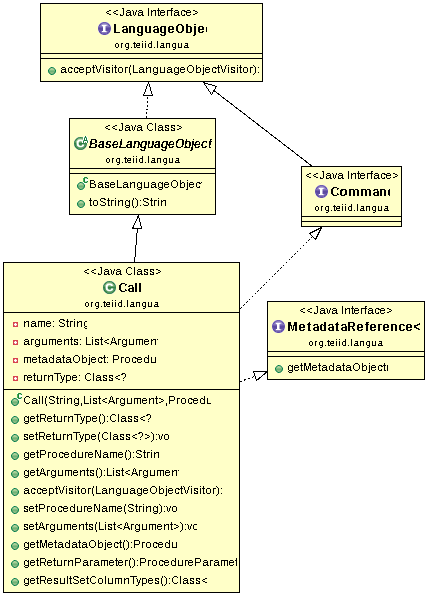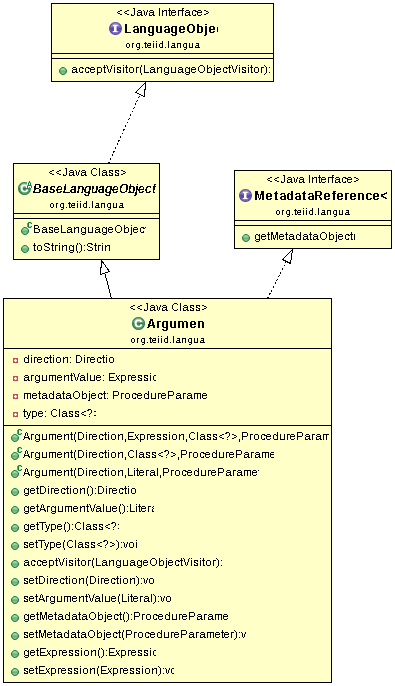Teiid Language API
This document introduce the Teiid language API with UML diagram and Junit Test code.
Hierarchy Architecture
All these class under package org.teiid.language:
-
LanguageObjectis the root interface for all language object interfaces -
LanguageObject,Command,BatchedCommand,Expression,InsertValueSource,TableReferenceare interfaces -
BaseLanguageObjectis abstract class for all language objects, all these language objects implement reference above interface
LanguageObject
├── BaseLanguageObject
│ ├── Argument
│ ├── BatchedUpdates
│ ├── Call
│ ├── ColumnReference
│ ├── Condition
│ │ ├── AndOr
│ │ ├── BaseInCondition
│ │ │ ├── In
│ │ │ └── SubqueryIn
│ │ ├── Comparison
│ │ ├── Exists
│ │ ├── IsNull
│ │ ├── Like
│ │ ├── Not
│ │ └── SubqueryComparison
│ ├── Delete
│ ├── DerivedColumn
│ ├── DerivedTable
│ ├── ExpressionValueSource
│ ├── Function
│ │ └── AggregateFunction
│ ├── GroupBy
│ ├── Insert
│ ├── Join
│ ├── Limit
│ ├── Literal
│ ├── NamedTable
│ ├── OrderBy
│ ├── Parameter
│ ├── QueryExpression
│ │ ├── Select
│ │ └── SetQuery
│ ├── ScalarSubquery
│ ├── SearchedCase
│ ├── SearchedWhenClause
│ ├── SetClause
│ ├── SortSpecification
│ ├── Update
│ ├── WindowFunction
│ ├── WindowSpecification
│ ├── With
│ └── WithItem
├── Command
│ ├── BatchedUpdates
│ ├── Call
│ ├── QueryExpression
│ │ ├── Select
│ │ └── SetQuery
│ └── BatchedCommand
│ ├── Delete
│ ├── Insert
│ └── Update
├── Expression
│ ├── Array
│ ├── ColumnReference
│ ├── Condition
│ │ ├── AndOr
│ │ ├── BaseInCondition
│ │ │ ├── In
│ │ │ └── SubqueryIn
│ │ ├── Comparison
│ │ ├── Exists
│ │ ├── IsNull
│ │ ├── Like
│ │ ├── Not
│ │ └── SubqueryComparison
│ ├── Function
│ │ └── AggregateFunction
│ ├── Literal
│ ├── Parameter
│ ├── ScalarSubquery
│ ├── SearchedCase
│ └── WindowFunction
├── InsertValueSource
│ ├── ExpressionValueSource
│ └── QueryExpression
│ ├── Select
│ └── SetQuery
└── TableReference
├── DerivedTable
├── Join
└── NamedTable
org.teiid.language.MetadataReference
The Interface MetadataReference only define one method:
public interface MetadataReference<T extends AbstractMetadataRecord> {
T getMetadataObject();
}
This interface is used to mark language objects as having a reference to a MetadataID. There are some language objects implement the MetadataReference, the Hierarchy Architecture as below:
MetadataReference
├── Argument
├── Call
├── ColumnReference
├── Function
│ └── AggregateFunction
└── NamedTable
org.teiid.language.Call

- The
Callrepresents a procedural execution (such as a stored procedure). - The
LanguageObjectis root interface for all language object interfaces. - The
MetadataReferenceused to mark language objects as having a reference to a MetadataID. - The
Commandrepresents a command in the language objects. A command is an instruction of something to execute sent to the connector. Typical commands perform SELECT, INSERT, UPDATE, DELETE, etc type operations.
org.teiid.language.Argument

A Junit code snippets for using above API:
@Test
public void testCall() {
Literal literal = new Literal("marketdata.csv", TypeFacility.RUNTIME_TYPES.STRING);
Argument argument = new Argument(Direction.IN, literal, TypeFacility.RUNTIME_TYPES.STRING, null);
Call call = LanguageFactory.INSTANCE.createCall("getTextFiles", Arrays.asList(argument), null);
assertEquals("getTextFiles", call.getProcedureName());
assertNotNull(call.getArguments());
}
org.teiid.language.visitor.LanguageObjectVisitor
As above Hierarchy Tree, LanguageObject is the root interface, it only define one method:
public interface LanguageObject {
void acceptVisitor(LanguageObjectVisitor visitor);
}
Which enbles all language objects accept Visitor, this method referred a parameter LanguageObjectVisitor, it have a series method invoked by language object:
public interface LanguageObjectVisitor {
public void visit(AggregateFunction obj);
public void visit(BatchedUpdates obj);
public void visit(ExpressionValueSource obj);
public void visit(Comparison obj);
public void visit(AndOr obj);
public void visit(Delete obj);
public void visit(ColumnReference obj);
public void visit(Call obj);
public void visit(Exists obj);
public void visit(Function obj);
public void visit(NamedTable obj);
public void visit(GroupBy obj);
public void visit(In obj);
public void visit(DerivedTable obj);
public void visit(Insert obj);
public void visit(IsNull obj);
public void visit(Join obj);
public void visit(Like obj);
public void visit(Limit obj);
public void visit(Literal obj);
public void visit(Not obj);
public void visit(OrderBy obj);
public void visit(SortSpecification obj);
public void visit(Argument obj);
public void visit(Select obj);
public void visit(ScalarSubquery obj);
public void visit(SearchedCase obj);
public void visit(DerivedColumn obj);
public void visit(SubqueryComparison obj);
public void visit(SubqueryIn obj);
public void visit(Update obj);
public void visit(SetQuery obj);
public void visit(SetClause obj);
public void visit(SearchedWhenClause obj);
public void visit(With obj);
public void visit(WithItem obj);
public void visit(WindowFunction windowFunction);
public void visit(WindowSpecification windowSpecification);
public void visit(Parameter obj);
public void visit(Array array);
}
For example, in above UML diagram section, the org.teiid.language.Call’s acceptVisitor implementation looks:
public void acceptVisitor(LanguageObjectVisitor visitor) {
visitor.visit(this);
}
also the org.teiid.language.Argument’s acceptVisitor implementation looks:
public void acceptVisitor(LanguageObjectVisitor visitor) {
visitor.visit(this);
}
Under package org.teiid.language.visitor there are some default implementation, the Hierarchy Architecture as below:
LanguageObjectVisitor
└── AbstractLanguageVisitor
├── HierarchyVisitor
│ ├── CollectorVisitor
│ └── DelegatingHierarchyVisitor
└── SQLStringVisitor
- LanguageObjectVisitor - root interface
- AbstractLanguageVisitor - an abstract class let the instance invoke the type-specific visit() method
- SQLStringVisitor - Creates a SQL string for a LanguageObject subtree. Instances of this class are not reusable, and are not thread-safe.
- HierarchyVisitor - Visits each node in a hierarchy of LanguageObjects. The default implementation of each visit() method is simply to visit the children of a given LanguageObject, if any exist, with this HierarchyVisitor (without performing any actions on the node). A subclass can selectively override visit() methods to delegate the actions performed on a node to another visitor by calling that Visitor’s visit() method. This implementation makes no guarantees about the order in which the children of an LanguageObject are visited
- CollectorVisitor - This visitor can be used to collect all objects of a certain type in a language tree. Each visit method does an instanceof method to check whether the object is of the expected type.
- DelegatingHierarchyVisitor - Delegates pre- and post-processing for each node in the hierarchy to delegate visitors.